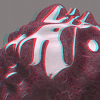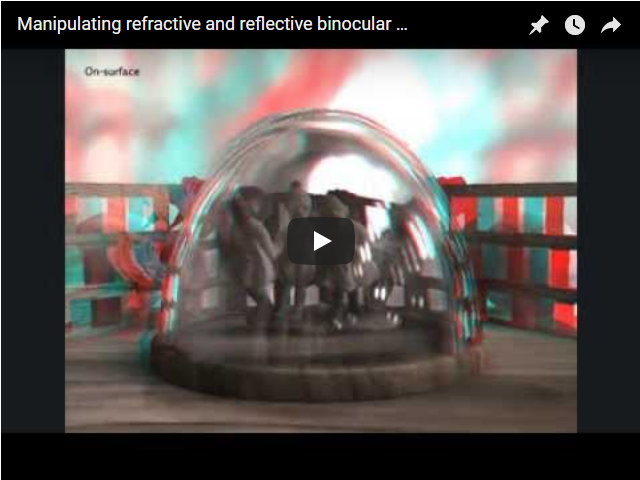
Manipulating refractive and reflective binocular disparity, Eurographics 2014
Manipulating refractive and reflective binocular disparity
Łukasz Dąbała1,4
Petr Kellnhofer1
Tobias Ritschel1,3
Piotr Didyk2
Krzysztof Templin1,2
Karol Myszkowski1
Przemysław Rokita4
Hans-Peter Seidel1
1MPI Informatik
2MIT CSAIL
3Saarland University
4Warsaw University of Technology

We split a synthetic stereo image (a) into a ray tree (b), and compute its multiple disparity interpretations (c), which are put into a cost function (d), that are used to find new camera setting (e) leading to an optimized combined stereo image (f).
Abstract
Presenting stereoscopic content on 3D displays is a challenging task, usually requiring manual adjustments. A number of techniques have been developed to aid this process, but they account for binocular disparity of surfaces that are diffuse and opaque only. However, combinations of transparent as well as specular materials are common in the real and virtual worlds, and pose a significant problem. For example, excessive disparities can be created which cannot be fused by the observer. Also, multiple stereo interpretations become possible, e. g., for glass, that both reflects and refracts, which may confuse the observer and result in poor 3D experience. In this work, we propose an efficient method for analyzing and controlling disparities in computer-generated images of such scenes where surface positions and a layer decomposition are available. Instead of assuming a single per-pixel disparity value, we estimate all possibly perceived disparities at each image location. Based on this representation, we define an optimization to find the best per-pixel camera parameters, assuring that all disparities can be easily fused by a human. A preliminary perceptual study indicates, that our approach combines comfortable viewing with realistic depiction of typical specular scenes.
Video
Downloads
|
Related Publications
 |
Highlight Microdisparity for Improved Gloss Depiction
Krzysztof Templin, Piotr Didyk, Tobias Ritschel, Karol Myszkowski, Hans-Peter Seidel ACM Transactions on Graphics 29(4) (Proceedings SIGGRAPH 2012, Los Angeles).
|
Citation
Łukasz Dąbała, Petr Kellnhofer, Tobias Ritschel, Piotr Didyk, Krzysztof Templin, Karol Myszkowski, Przemysław Rokita, Hans-Peter Seidel
Manipulating refractive and reflective binocular disparity
Computer Graphics Forum 33(2) (Proc. Eurographics 2014), 2014.
@article{dabala:2014:StereoRefraction,
author = {
{\L}ukasz D\k{a}ba\l{}a and
Petr Kellnhofer and
Tobias Ritschel and
Piotr Didyk and
Krzysztof Templin and
Karol Myszkowski and
Przemys\l{}aw Rokita and
Hans-Peter Seidel},
title = {Manipulating refractive and reflective binocular disparity},
journal = {Computer Graphics Forum (Proc. Eurographics 2014)},
year = {2014},
volume = {33},
number = {2},
issn = {1467-8659},
url = {http://dx.doi.org/10.1111/cgf.12290},
doi = {10.1111/cgf.12290},
pages = {53--62}
}
Computer Graphics Forum © 2014 The Eurographics Association and Blackwell Publishing Ltd. Published by Blackwell Publishing, 9600 Garsington Road, Oxford OX4 2DQ, UK and 350 Main Street, Malden, MA 02148, USA.
This is the author's version of the work. It is posted here by permission of EUROGRAPHICS / Blackwell Publishing for your personal use. Not for redistribution.
The definitive version was published in at http://diglib.eg.org and http://onlinelibrary.wiley.com.
DOI: 10.1111/cgf.12290.
